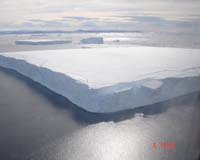Tides impact ice sheet more than expected.
 Another new piece of the puzzle falls into place. It has been assumed that the breaking of the Antarctic ice sheet is the result of anthropogenic global warming. But a new factor has been added.
Another new piece of the puzzle falls into place. It has been assumed that the breaking of the Antarctic ice sheet is the result of anthropogenic global warming. But a new factor has been added.It was known the ice sheet moves according to the twice daily tidal activity. But now it is discovered that “the rate varies 20 per cent in tandem with two-week tidal cycles” as well. And this “effect is felt even on ice more than 40 km inland.” And it is thought it could be felt even 75 km inland as well.
A glaciologist with the British Antarctic Survey, Hilmar Gudmundsson, said “We’ve know that the tides affect the motion of ice streams but we didn’t know it happened on this two-weekly scale.”
According to the press reports “Computer models of how Antarctica’s ice might be affected by rising seas and global warming... would now have to factor in tides....”
So here is a brand new factor in the break up of the Antarctic ice shelf. Now I wonder if there is a similar issue at work in the Arctic ice shelf as well. That seems reasonable. Yet when a large chunk of ice broke off recently in the Arctic there was no shortage of press reports attributing the break up to “the result of global warming.” Tidal influences were not mentioned.
In some ways it strikes me that any unusual activity in nature is automatically attributed to global warming until some other factor is discovered. Now there might be reasons that what the tides do in the Antarctic are not also true in the Artic. But shouldn't those be explained before blaming global warming?
 DiggIt!
DiggIt! Reddit
Reddit Del.icio.us
Del.icio.us

<< Home